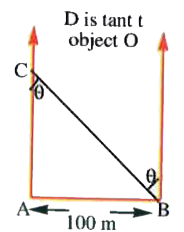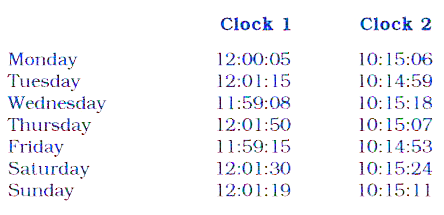Complete Solutions to EXAMPLE of chapter UNITS AND MEASUREMENT of Class 11 book with complete answers and questions
| Class 11 | PHYSICS |
| Chapter | UNITS AND MEASUREMENT |
| NCERT TELUGU | EXAMPLE |
| Number Of Questions | 17 |
| Academic Year | 2023-24 |
Calculate the angle of (a) `1^(@)` (degree) (b) 1' (minute of arc or arcmin) and `("c")` 1" (second of arc or arc second ) in radians. Use `360^(@) = 2pi` rad, `1^(@)=60'` and 1'=60".
View SolutionA man wishes to estimate the distance of a nearby tower from him. He stands at a point A in front of the tower C and spots a very distant object in line with AC. He then walks perpendicular to AC up to B, a distance of 100 m, and looks at O and C again. Since O is very distant, the direction BO is practically the same as AO, but he finds the line of sight of C shifted from the original line of sight by an angle = `40^@` (`theta ` is known as 'parallax') estimate the distance of the tower C from his original position A.

View SolutionFrom two diametrically opposite points A and B on earth, moon is observed. The angle `theta` subtended at the moon by the two directions of observation is `1^@ 54^1`. If radius of earth is` 0.638 xx 10^7` m, find the distance of the moon from the earth.
View SolutionThe Sun's angular diameter is measured to be 1920". The distance D of the Sun from the Earth is `1.496xx109^(11)` m. What is the diameter of the Sun ?
View SolutionIf the size of a nucleus (in the range of `10^(-15) m to 10^(14)` m) is scaled up to the tip of a sharp pin, what roughly is the size of an atom ? Assume tip of the pin to be in the range `10^(-5) ` to ` 10^(-4)` m.
View SolutionTwo clocks are being tested against a standard clock located in a national laboratory . At 12:00:00 noon by the standard clock, the regarding of the two clocks are :

If you are doing an experiment that requires precision time interval measurements, which of the two clocks will you prefer ?
View SolutionThe readings of a length come out to be 2.63 m , 2.56 m , 2.42 m , 2.71 m and 2.80 m . Calculate the absolute errors and relative errors or percentage errors. What do you think of the actual value of the length and its limits ?
View SolutionThe temperature of two bodies measured by a thermometer are `t_(1) = 20^(@)C pm 0.5^(@)C` and `t_(2)=50^(@)C pm 0.5^(@)C`. Calculate the temperature difference and the error theirin.
View SolutionThe resistance R=V/I where V=`(100 pm5)V` and I=`(10 pm 0.2)A`. Find the percentage error in R.
View SolutionTwo resistors of resistances `R_1 = 100 pm 3` ohm and `R_2 = 200 pm 4 ` ohm are connected (a) in series , (b) in parrallel. Find the equivalent resistance of the (a) series combination , (b) parallel combination . Use for (a) the relation `R = R_1 + R_2 and ` for (b) `1/R = 1/(R_1) + 1/(R_2) and (DeltaR')/(R^(,2)) = (DeltaR_1)/(R_1^2) + (DeltaR_2)/(R_2^2)`
View SolutionFind the relative error in Z, if Z = `A^(4)B^(1/3)/CD^(3/2)`.
View SolutionThe period of oscillation of a simple pendulum is T =`2pisqrt(L/g)`. Measuted value of L is 20.0 cm known to 1mm accuracy and time for 100 oscillations of the pendulum is found to be 90s using a wrist watch of 1 s resolution. What is the accuracy in the determination of g ?
View SolutionEach side of a cube is measured to be 7.203m. What is (i) the total surface area and (ii) the volume of the cube to appropriate significant figures ?
View SolutionFind the number of significant figures in the 6.0023
View SolutionLet us consider an equation `(1)/(2)mv^(2)=mgh`
Where m is the mass of the body. V its velocity , g is the acceleration due to gravity and h is the height . Check whether this equation is dimensionally correct.
View SolutionThe SI unit of energy is `J=kg m^(2)s^(-2)`, that of speed v is `ms^(-1)` and of acceleration a is `ms^(-2)`. What of the formulae for kinetic energy (k) given below can you rule out on the basis of dimensional arguments (m stands for the mass of the body) :
(a) `K = m^(2)v^(2)`
(b) `K = (1/2)mv^(2)`
`("c") K= ma`
(d) `K = (3/16)mv^(2)`
(e) `K=(1/2)mv^(2)+ma`
View SolutionConsider a simple pendulum, having a bob attached to a string, that oscillates under the action of the force of gravity. Suppose that the period of oscillation of the simple pendulum depends on its length (l), mass of the bob (m) and acceleration due to gravity (g). Derive the expression for its time period using method of dimensions.
View Solution
EXAMPLE questions and complete solutions for chapter UNITS AND MEASUREMENT of NCERT PHYSICS(TELUGU) of Class 11